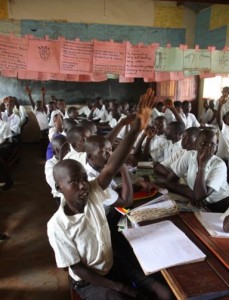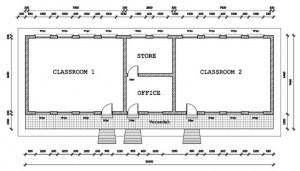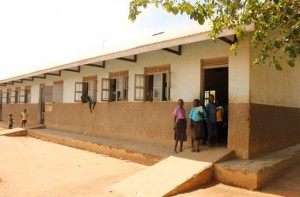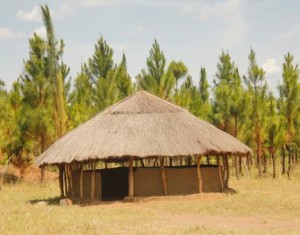How well-designed classrooms contribute to a quality education!
April 13, 2016The classroom environment can improve students’ academic performance by 25% according to a recent study conducted by the University of Salford.
 Over the last 10 years, African Revival has been working to improve the quality of teaching and learning at primary schools in Uganda and Zambia. We also provide facilities which improve access to education and are conducive to learning. Schools in northern Uganda were targeted by rebel forces during the 20 year insurgency by the Lord’s Resistance Army. School infrastructure was destroyed and many children missed out on access to education. In the decade since peace was restored, we’ve learnt a thing or two about classroom construction.
Over the last 10 years, African Revival has been working to improve the quality of teaching and learning at primary schools in Uganda and Zambia. We also provide facilities which improve access to education and are conducive to learning. Schools in northern Uganda were targeted by rebel forces during the 20 year insurgency by the Lord’s Resistance Army. School infrastructure was destroyed and many children missed out on access to education. In the decade since peace was restored, we’ve learnt a thing or two about classroom construction.
Vincent Komakech, based at our Gulu office in Uganda, has been African Revival’s Construction Project Coordinator for 3 years. Vincent has given us his expert opinion on the design of quality classrooms suited to the local environment.
 Orientation
Orientation
Firstly, orientation of the building is key. Typically, classrooms are a long oblong shape with windows running along the two longer walls. Building a classroom so that the two windowless walls face East and West means that no direct sunlight will penetrate the windows. This avoids the distraction of sunlight in pupils’ and teachers’ eyes at the beginning and end of the day as the sun rises and sets.
 Durability and Insulation
Durability and Insulation
Secondly, the materials used to build and roof a classroom should be durable and strong enough to withstand wear and tear over time. Classrooms are built to last approximately 30-40 years, but ideally longer before having to be repaired or replaced. Depending on the individual school, classrooms need to hold anything between 30 to 90 students at one time so buildings also need to be a substantial size.
Some government funded secondary schools are built with insulation to reflect heat away from the building, helping to keep it cooler and more conducive to learning. Adding extra layers of plaster to the roof can also muffle the sound of heavy rains which fall between April and September. Unfortunately, such insulation is not used in the construction of most primary school classrooms often due to budget constraints. This makes teaching and learning effectively that much harder in the rainy season.
 Light and Ventilation
Light and Ventilation
Ideally, windows should be large enough to allow adequate ventilation and light. With no access to electricity being the norm at most of the schools we work with, natural daylight is used as essential lighting in classrooms. Air should also be able to flow in and out allowing for a breeze to pass through the classrooms, so windows are purposefully not fitted with glass. Temperatures in northern Uganda can regularly reach over 30 degrees Celsius in the dry season, so a breeze is keenly welcomed by pupils and teachers!
 Windows Where possible, windows should be lined with insect-proof screens, similar to mosquito nets but more solid and durable. These not only prevent small insects from using the classroom as a home, but also birds and bats which may leave behind unwanted debris and smells. Small animals may also damage the roofing meaning that is has to be replaced sooner. Using these screens prevents damage caused by animals, making the classrooms more durable in the long term. Windows should also be placed high enough in the wall so that when a student is sat at a desk they cannot be distracted by what is going on outside. Simple ideas such as this can help improve the focus and concentration of students in class.
Windows Where possible, windows should be lined with insect-proof screens, similar to mosquito nets but more solid and durable. These not only prevent small insects from using the classroom as a home, but also birds and bats which may leave behind unwanted debris and smells. Small animals may also damage the roofing meaning that is has to be replaced sooner. Using these screens prevents damage caused by animals, making the classrooms more durable in the long term. Windows should also be placed high enough in the wall so that when a student is sat at a desk they cannot be distracted by what is going on outside. Simple ideas such as this can help improve the focus and concentration of students in class.
 Walls and Floors
Walls and Floors
Finally, walls and floors should be easy to clean so that a hygienic and attractive environment is maintained. Vincent describes “walls that talk to the learning students” by which he means wall surfaces which teachers can decorate with posters, slogans and pictures. Doors with a strong lock should also be installed so that classrooms and their contents are secure when not in use.
“These are some of the features that I think are worth considering for a good classroom… If you have good classrooms with some of the features I’ve suggested, I’d like to think concentration levels would go up for the learners. The teachers will not have interferences with their lessons. That means the contact hours that are planned for each syllabus should be accomplished in time. It can provide room for revision, and remedial lessons. Most of the syllabus can be finished by say, the beginning of the third term, and you have time for remedial lessons and revision, then definitely the performance of the students should improve.”
 Many of Vincent’s recommendations are included in the design given to government-supported schools by the Ugandan Ministry of Education. However, many rural primary schools are not given any funding or support from the government. This means that their budgets for classrooms are very limited. Often classrooms will be in the form of round mud brick huts with thatched roofs. These classrooms tend to be paid for and built by parents, the PTA and School Management Committees. These buildings need constant maintenance and are likely to leak in heavy rains which makes teaching and learning more difficult.
Many of Vincent’s recommendations are included in the design given to government-supported schools by the Ugandan Ministry of Education. However, many rural primary schools are not given any funding or support from the government. This means that their budgets for classrooms are very limited. Often classrooms will be in the form of round mud brick huts with thatched roofs. These classrooms tend to be paid for and built by parents, the PTA and School Management Committees. These buildings need constant maintenance and are likely to leak in heavy rains which makes teaching and learning more difficult.
Over the last 3 years African Revival has supported 57 schools in Uganda & Zambia in a variety of ways. In terms of construction work we have built 4 classrooms, 2 teachers’ houses, 4 toilet blocks, 1 girl’s dormitory and refurbished a library. We hope that with the generous support of our donors we will be able to provide more quality classrooms and other school buildings to schools which are seriously lacking in facilities. Some schools have such high enrolment rates that there may be over 90 students in a classroom built for just 45. With more well-designed classrooms, schools can provide more students with a quality education.
If you’d like to contribute to the construction of a classroom, or another school building, please do get in touch on 020 8939 3190 or info@africanrevival.org
